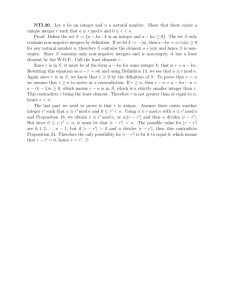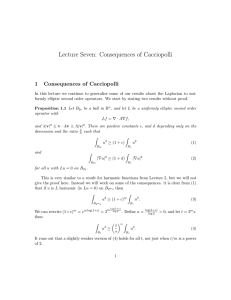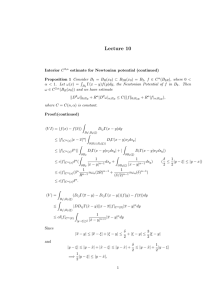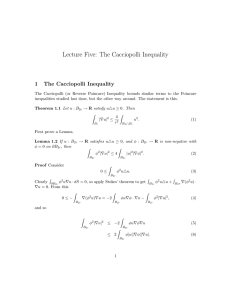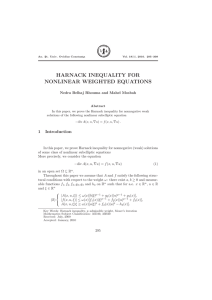On Arithmetic Progressions of Integers with a Distinct Sum of Digits Italy
advertisement
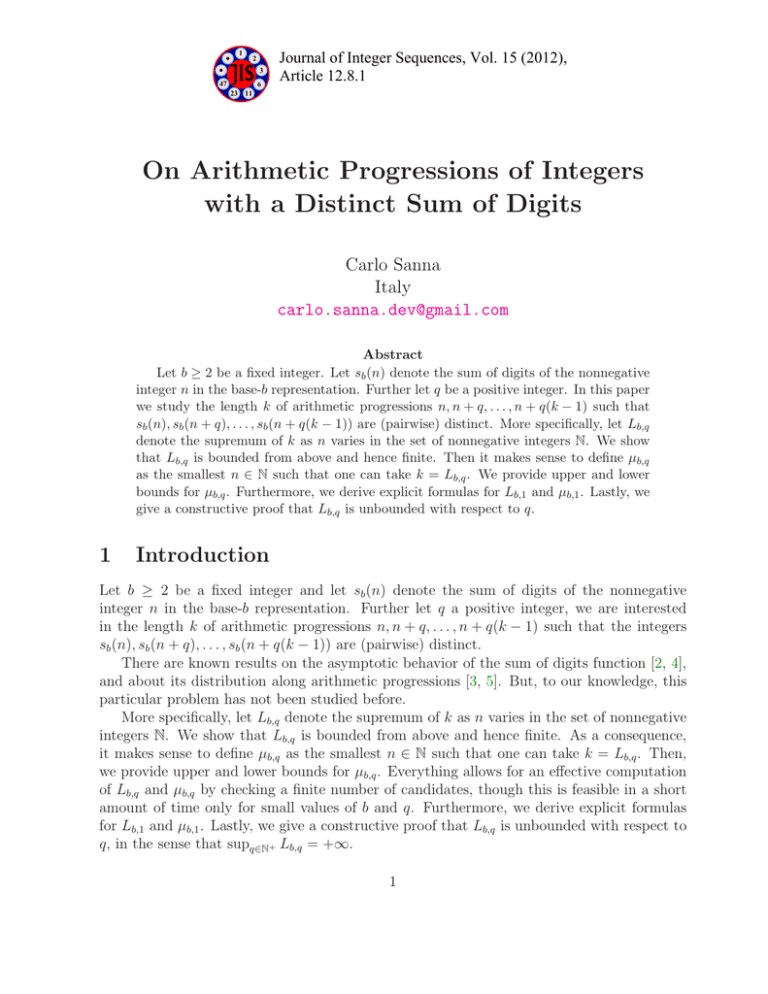
1
2
3
47
6
Journal of Integer Sequences, Vol. 15 (2012),
Article 12.8.1
23 11
On Arithmetic Progressions of Integers
with a Distinct Sum of Digits
Carlo Sanna
Italy
carlo.sanna.dev@gmail.com
Abstract
Let b ≥ 2 be a fixed integer. Let sb (n) denote the sum of digits of the nonnegative
integer n in the base-b representation. Further let q be a positive integer. In this paper
we study the length k of arithmetic progressions n, n + q, . . . , n + q(k − 1) such that
sb (n), sb (n + q), . . . , sb (n + q(k − 1)) are (pairwise) distinct. More specifically, let Lb,q
denote the supremum of k as n varies in the set of nonnegative integers N. We show
that Lb,q is bounded from above and hence finite. Then it makes sense to define µb,q
as the smallest n ∈ N such that one can take k = Lb,q . We provide upper and lower
bounds for µb,q . Furthermore, we derive explicit formulas for Lb,1 and µb,1 . Lastly, we
give a constructive proof that Lb,q is unbounded with respect to q.
1
Introduction
Let b ≥ 2 be a fixed integer and let sb (n) denote the sum of digits of the nonnegative
integer n in the base-b representation. Further let q a positive integer, we are interested
in the length k of arithmetic progressions n, n + q, . . . , n + q(k − 1) such that the integers
sb (n), sb (n + q), . . . , sb (n + q(k − 1)) are (pairwise) distinct.
There are known results on the asymptotic behavior of the sum of digits function [2, 4],
and about its distribution along arithmetic progressions [3, 5]. But, to our knowledge, this
particular problem has not been studied before.
More specifically, let Lb,q denote the supremum of k as n varies in the set of nonnegative
integers N. We show that Lb,q is bounded from above and hence finite. As a consequence,
it makes sense to define µb,q as the smallest n ∈ N such that one can take k = Lb,q . Then,
we provide upper and lower bounds for µb,q . Everything allows for an effective computation
of Lb,q and µb,q by checking a finite number of candidates, though this is feasible in a short
amount of time only for small values of b and q. Furthermore, we derive explicit formulas
for Lb,1 and µb,1 . Lastly, we give a constructive proof that Lb,q is unbounded with respect to
q, in the sense that supq∈N+ Lb,q = +∞.
1
2
Bounds for Lb,q and µb,q
Theorem 1. Let m be the least positive integer such that
m
b
m(b − 1) + 1 ≤
.
q
(1)
Then Lb,q ≤ 2⌊bm /q⌋.
Proof. Let n ∈ N, k ∈ N+ and A := {n + qi : i = 0, 1, . . . , k − 1} such that sb (n), sb (n + q),
. . ., sb (n + q(k − 1)) are distinct. For any t ∈ N we define At := A ∩ [tbm , (t + 1)bm − 1].
For convenience, take M := ⌊bm /q⌋. Then for all nonnegative integers t < u the following
statements are true:
(i). |At | ≤ M .
(ii). At , Au 6= ∅ ⇒ ∀v ∈ N, t < v < u |Av | = M .
(iii). |At | = M, t 6≡ −1 (mod b) ⇒ ∀u ∈ N, u > t Au = ∅.
(iv). |At | = M, t 6≡ 0 (mod b) ⇒ ∀u ∈ N, u < t Au = ∅.
(i). For all a ∈ At we have sb (a) = sb (t) + sb (a mod bm ) and therefore
sb (At ) := {sb (a) : a ∈ At } ⊆ {sb (t), sb (t) + 1, . . . , sb (t) + m(b − 1)},
(2)
so by the hypotheses |At | = |sb (At )| ≤ m(b − 1) + 1 ≤ M .
(ii). Since At , Au are nonempty we have n < vbm and (v + 1)bm − 1 < n + q(k − 1). Then
|Av | = {qi : i = 0, . . . , k − 1} ∩ [vbm − n, (v + 1)bm − n − 1] m
b
m
m
= M,
(3)
= qN ∩ [vb − n, (v + 1)b − n − 1[ ≥
q
because qN ∩ [x, y] ≥ ⌊(y − x + 1)/q⌋ for any integers y ≥ x ≥ 0. From point (i) it follows
that |Av | = M .
(iii). We have sb (t + 1) = sb (t) + 1. Suppose by contradiction that At+1 is nonempty,
so there exists a := min(At+1 ). Now sb (a) = sb (t) + 1 + sb (a mod bm ) and, since |At | = M
implies sb (At ) = {sb (t), sb (t) + 1, . . . , sb (t) + m(b − 1)}, then necessarily sb (a mod bm ) =
m(b − 1), so that a = (t + 2)bm − 1. In fact, sb (a mod bm ) ≤ m(b − 1) and if we suppose
sb (a mod bm ) < m(b − 1) then sb (a) ∈ sb (At ), in contradiction to our standing hypotheses.
But q ≤ M1 bm ≤ bm−1 , so a − q ≥ (t + 1)bm and a − q ∈ At+1 , a contradiction. In conclusion
At+1 = ∅ and, since q < bm , this implies Au = ∅.
(iv). Note that t ≥ 1, we have sb (t − 1) = sb (t) − 1. Suppose that At−1 is nonempty, so
there exists a := max(At−1 ). Then sb (a) = sb (t) − 1 + sb (a mod bm ) and, since |At | = M
implies sb (At ) = {sb (t), sb (t) + 1, . . . , sb (t) + m(b − 1)}, then it must be sb (a mod bm ) = 0
that is a = (t − 1)bm . But a + q ≤ tbm − 1 so a + q ∈ At−1 , a contradiction. Thus At−1 = ∅
and, since q < bm , it follows that Au = ∅.
S
The sets {At }∞
t=0 form a partition of A, hence A =
t∈N At . On the other hand, for the
statements proved, we have that at most two of the sets {At }∞
t=0 are nonempty and their
cardinality is less than or equal to M . In conclusion k = |A| ≤ 2M .
2
Corollary 2. Lb,1 = 2b, µ2,1 = 14 and µb,1 = b3 − b if b ≥ 3.
Proof. From Theorem 1 we know that Lb,1 ≤ 2b. It is easy to verify that L2,1 = 4 and
µ2,1 = 14 (OEIS A000120). If b ≥ 3 then Lb,1 = 2b and µb,1 ≤ b3 − b because
(
2(b − 1) + i, if i = 0, 1, . . . , b − 1;
sb (b3 − b + i) =
(4)
i − b + 1,
if i = b, b + 1, . . . , 2b − 1.
Now let n < b3 − b be a nonnegative integer. Write n = d2 b2 + d1 b + d0 with d0 , d1 , d2 ∈
{0, 1, . . . , b − 1}. If d1 6= b − 1 then let m be the least integer greater than or equal to n and
not divisible by b. We have m ≤ n + 1 and sb (m) = sb (m + b − 1). If d1 = b − 1 and d0 = 0
then d2 ≤ b − 2, since n < b3 − b, and so sb (n) = sb (n + 2b − 2). If d1 = b − 1 and d0 6= 0
then let h := (d2 + 1)b2 . We have h ≤ n + b − 1 and sb (h + 1) = sb (h + b). In any case we
have found two integers u, v such that n ≤ u < v ≤ n + 2b − 1 and sb (u) = sb (v). Therefore
µb,1 ≥ b3 − b and actually µb,1 = b3 − b.
Theorem 3. Lb,bq = Lb,q and µb,bq = bµb,q .
Proof. For all n, i ∈ N and d ∈ {0, 1, . . . , b−1} we have sb (bn+d+bqi) = sb (n+qi)+d. Then
for any k ∈ N we have that sb (bn + d), sb (bn + d + bq), . . . , sb (bn + d + (k − 1)bq) are distinct
if and only if sb (bn), sb (bn + bq), . . . , sb (bn + (k − 1)bq) are distinct, which in turn holds if
and only if sb (n), sb (n + q), . . . , sb (n + (k − 1)q) are distinct. In conclusion Lb,bq = Lb,q and
µb,bq = bµb,q .
Theorem 4. µb,q > b
Lb,q −b
b−1
− q(Lb,q − 1).
Proof. Let r := ⌊logb (µb,q + q(Lb,q − 1))⌋ + 1. Since sb (µb,q ), sb (µb,q + q), . . . sb (µb,q + q(k − 1))
are distinct and less than or equal to r(b − 1), then
Lb,q ≤ r(b − 1) + 1 < (b − 1) logb (µb,q + q(Lb,q − 1)) + b.
Solving (5) for µb,q we get µb,q > b
Lb,q −b
b−1
(5)
− q(Lb,q − 1).
Theorem 5. µb,q ≤ b3 [q(Lb,q − 1)]2 − 1.
Proof. Take r := ⌊logb (q(Lb,q − 1))⌋ + 1, µ := (µb,q mod br ), m := ⌊µb,q /br ⌋, so that µb,q =
mbr + µ, and let i ∈ {0, 1, . . . , Lb,q − 1}. If µ + qi < br then
sb (µb,q + qi) = sb (m) + sb (µ + qi),
(6)
sb (µb,q + qi) = sb (m + 1) + sb (µ + qi − br ),
(7)
else if µ + qi ≥ br then
for the fact that µ + qi ≤ 2br − 2. Define n := (br+1 − 1)br + µ, if µ + qi < br then
sb (n + qi) = sb (br+1 − 1) + sb (µ + qi) = (r + 1)(b − 1) + sb (µ + qi) > r(b − 1).
3
(8)
On the other hand, if µ + qi ≥ br then
sb (n + qi) = sb (br+1 ) + sb (µ + qi − br ) = 1 + sb (µ + qi − br ) ≤ r(b − 1),
because µ + qi − br ≤ br − 2 and so sb (µ + qi − br ) ≤ r(b − 1) − 1.
sb (n), sb (n + q), . . . , sb (n + q(Lb,q − 1)) are distinct and
(9)
In conclusion
µb,q ≤ n ≤ b2r+1 − 1 ≤ b3 [q(Lb,q − 1)]2 − 1,
(10)
this completes our proof.
3
Arbitrarily large values of Lb,q
For the next theorem we need a lemma about the sum of digits of multiples of br − 1, r ∈ N+ .
Similar results has been considered by Stolarsky [6, Lemma 2.2] in the case b = 2, and by
Balog and Dartyge [1, Lemma 1] for a generic base b.
Lemma 6. If r ∈ N+ then sb ((br − 1)i) = r(b − 1) for all i = 1, 2, . . . , br − 1.
Proof. Let t be the greatest nonnegative integer such that bt | i. IfPi0 := b−t i then there
r−1
exist d0 , d1 , . . . , dr−1 ∈ {0, 1, . . . , b − 1} with d0 6= 0 such that i0 = j=0
dj bj is the base-b
representation of i0 . We have
r
(b − 1)i0 =
2r−1
X
j
dj−r b −
j=r
=
2r−1
X
r−1
X
d j bj
j=0
j
r
r
dj−r b + (d0 − 1)b + b −
j=r+1
=
2r−1
X
r−1
X
d j bj
j=0
dj−r bj + (d0 − 1)br +
j=r+1
r−1
X
(b − 1 − dj )bj + (b − d0 ).
(11)
j=1
Then it is straightforward that
r
sb ((b − 1)i0 ) =
2r−1
X
dj−r + (d0 − 1) +
j=r+1
r−1
X
(b − 1 − dj ) + (b − d0 ) = r(b − 1).
(12)
j=1
The claim follows from sb ((br − 1)i) = sb ((br − 1)i0 ).
Theorem 7. supq∈N+ Lb,q = +∞.
Proof. Let n ∈ N and q, k ∈ N+ such that sb (n), sb (n + q), . . . , sb (n + q(k − 1)) are distinct.
If t, r are the least positive integers such that n + qk < bt and (b − 1)br−1 ≥ k then we define
n′ = (bt − 1)b2r + b2r−1 + (br − 1)((b − 1)br−1 − k + 1) bt + n
q ′ = (br − 1)bt + q.
(13)
4
For any i = 0, 1, . . . , k we have
n′ + q ′ i = (bt − 1)b2r + b2r−1 + (br − 1)((b − 1)br−1 + i − k + 1) bt + n + qi,
(14)
and then
sb (n′ + q ′ i) = sb (bt − 1)b2r + b2r−1 + (br − 1)((b − 1)br−1 + i − k + 1) + sb (n + qi). (15)
If i ≤ k − 1 then (br − 1)((b − 1)br−1 + i − k + 1) < (b − 1)b2r−1 and
sb (n′ + q ′ i) = t(b − 1) + 1 + sb (br − 1)((b − 1)br−1 + i − k + 1) + sb (n + qi),
(16)
so Lemma 6 implies that
sb (n′ + q ′ i) = (t + r)(b − 1) + 1 + sb (n + qi) > (t + r)(b − 1).
(17)
On the other hand, if i = k then
sb (n′ + q ′ k) = sb b2r+t + br−1 − 1 + sb (n + qk) = 1 + (r − 1)(b − 1) + sb (n + qk)
≤ 1 + (t + r − 1)(b − 1) ≤ (t + r)(b − 1).
(18)
Therefore sb (n′ ), sb (n′ + q), . . . , sb (n′ + qk) are distinct, it follows that Lb,q′ > Lb,q and hence
supq∈N+ Lb,q = +∞.
4
Further developments
Thanks to Theorem 1 we know that Lb,q is not too large when q is small compared to b, e.g.,
if q ≤ 12 b then Lb,q ≤ 2b2 . Actually, it is likely that for small q there exist explicit formulas
for Lb,q and µb,q analogous to those of Corollary 2. However, when q is much larger than b
the question becomes more difficult. Theorem 1 and 5 allowed us, with the aid of a personal
computer, to calculate some values of µb,q and Lb,q .
µb,q , Lb,q
b=2
b=3
b=4
q=1
14, 4
24, 6
60, 8
q=2
28, 4
24, 3
56, 8
q=3
58, 4
72, 6
60, 3
q=4
56, 4
234, 5
240, 8
q=5
242, 6
705, 9
1004, 8
q=6
116, 4
72, 3
244, 4
q=7
109, 5
697, 10
977, 13
q=8
112, 4
18, 3
224, 8
q=9
994, 6
216, 6
239, 4
Table 1: Values of µb,q and Lb,q for b = 2, 3, 4 and q = 1, 2, . . . , 9.
Through these series of numerical experiments we have reason to believe that the upper
bound given by Theorem 1 is in some sense “astronomical” and surely can be improved.
Similarly, also the upper and lower bounds for µb,q can be improved.
Many other questions remain unsolved. For instance, let κb,q be the function sending the
nonnegative integer n to the maximum k ∈ N such that sb (n), sb (n + q), . . . , sb (n + q(k − 1))
are distinct. We proved that the function κb,q is bounded. Is κb,q definitely periodic? Does it
present a fractal behavior? What is its Fourier expansion? What is its mean, variance, etc.?
On the other side, for which n ∈ N is κb,q (n) particularly small? These and other questions
will be the subject of future investigations.
5
5
Acknowledgements
I am grateful to Salvatore Tringali (LJLL, Université Pierre et Marie Curie) for his careful
proofreading and, more generally, his valuable support in the field of Mathematics. I am
also thankful to the anonymous referee for his constructive comments.
References
[1] A. Balog and C. Dartyge, On the sum of the digits of multiples, Moscow J. Comb.
Number Th. 2 (2012), 3–15.
[2] L. E. Bush, An asymptotic formula for the average sum of the digits of integers, Amer.
Math. Monthly 47 (1940), 154–156.
[3] M. Drmota, C. Mauduit, and J. Rivat, The sum of digits function of polynomial sequences, J. Lond. Math. Soc. 84 (2011), 81–102.
[4] Y. Fang, A theorem on the k-adic representation of positive integers, Proc. Amer. Math.
Soc. 130 (2002), 1619–1622.
[5] A. O. Gelfond, Sur les nombres qui ont des propriété additives et multiplicative données,
Acta Arith. 13 (1967/1968), 259–265.
[6] K. B. Stolarsky, Integers whose multiples have anomalous digital frequencies, Acta Arith.
38 (1980), 117–128.
2010 Mathematics Subject Classification: Primary 11A63; Secondary 11A25, 11B25.
Keywords:
Elementary number theory, radix representation, sum of digits, arithmetic
progressions.
(Concerned with sequence A000120.)
Received August 5 2012; revised version received September 23 2012. Published in Journal
of Integer Sequences, October 2 2012.
Return to Journal of Integer Sequences home page.
6





